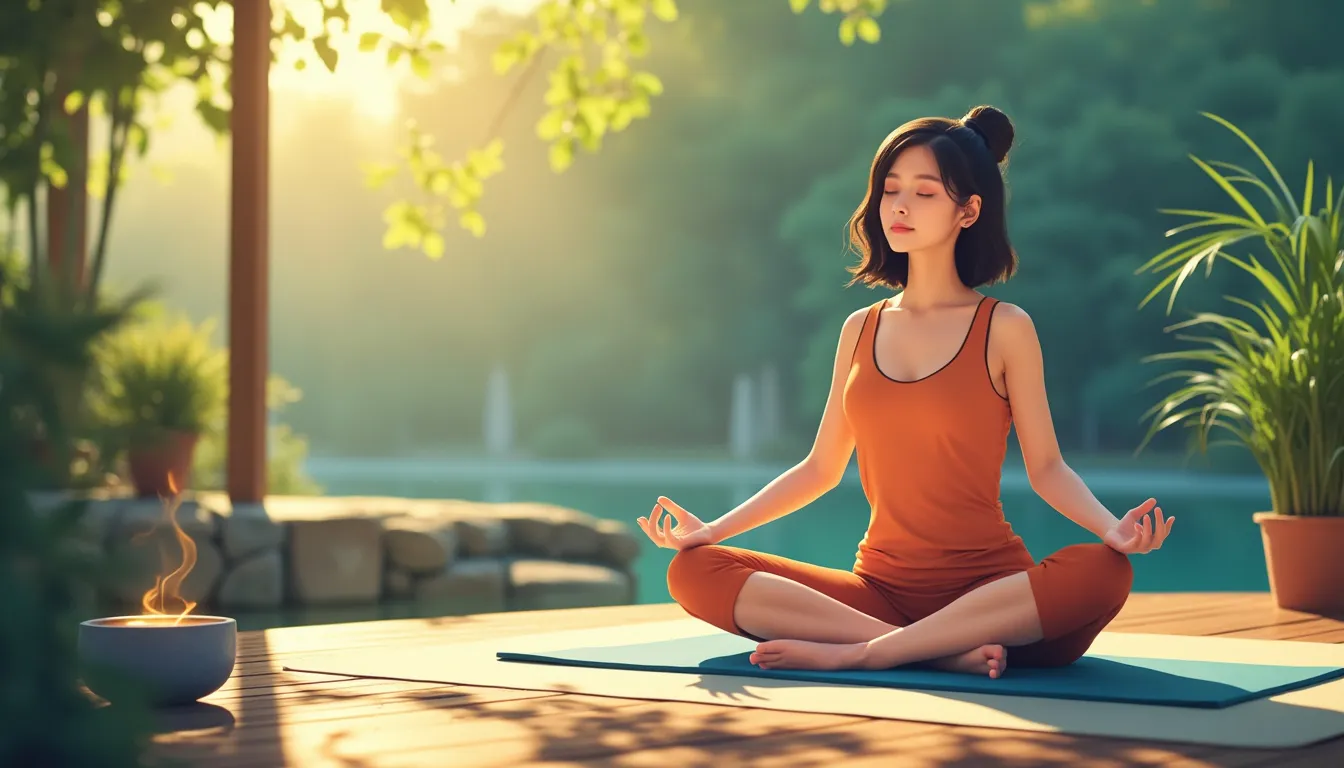Embarking on a meditation journey can be a transformative experience, offering profound benefits for the mind and body. In today’s fast-paced world, meditation provides a sanctuary of peace and clarity, helping to alleviate stress, enhance focus, and promote emotional well-being. Whether seeking to cultivate a deeper sense of inner calm or establishing a disciplined practice, understanding the fundamentals is essential. This beginner’s guide will walk you through the essentials of meditation, demystifying its practices and dispelling common misconceptions.
We start by delving into the essence of meditation, exploring its many benefits and various techniques. From mindful breathing exercises to guided visualisations, each practice presents unique opportunities for growth and reflection. Creating a comfortable space attuned to tranquility becomes paramount as you prepare for your meditation journey. We’ll guide you on setting the right environment, establishing meaningful intentions, and determining an optimal time and frequency for your sessions.
This guide introduces straightforward techniques to make the beginnings of your meditation practice approachable and effective. You’ll find practical advice on mindfulness exercises and strategies to overcome initial challenges, ensuring consistency on your path. With dedication and an open heart, your meditation practice can unfold into a deeply enriching experience, bringing balance and joy to your everyday life. Join us on this journey towards inner peace and self-discovery; your meditative path awaits.
Understanding Meditation: The Basics
Introduction to Meditation: What It Is and Its Benefits
Meditation, often rooted in ancient spiritual traditions, is a practice that involves focusing the mind on a particular object, thought, or activity to achieve mental clarity and emotional calmness. Although there are various forms of meditation, the core objective remains consistent: cultivating a peaceful state of mind.
The benefits of meditation are vast and supported by numerous studies. Some of the most notable advantages include:
- Stress Reduction: Regular meditation can help lower the levels of the stress hormone cortisol, thus enhancing resilience against everyday pressures.
- Improved Concentration: Meditation enhances the ability to focus and sustain attention for extended periods.
- Emotional Health: It can foster a more positive outlook on life by reducing symptoms of anxiety and depression.
- Enhanced Self-Awareness: It helps increase self-awareness and reflection, facilitating personal growth.
- Better Sleep: Many find that meditation before bed significantly improves the quality of their sleep.
Different Types of Meditation Practices Explained
Meditation is a diverse practice with multiple forms, each having its unique approach and focus. Understanding the different types can help you identify the one that resonates with you the most:
- Mindfulness Meditation: From Buddhist teachings, mindfulness meditation involves paying attention to your thoughts without judging them. It emphasises staying present and fully engaging with the current moment.
- Transcendental Meditation (TM) This involves silently repeating a mantra to settle the mind into restful awareness. TM aims to transcend ordinary thinking and reach a state of pure consciousness.
- Guided Meditation: Often led by an instructor or an audio recording, this form guides you through mental imagery and scenarios to promote relaxation and stress reduction.
- Loving-Kindness Meditation (Metta): This practice focuses on developing an attitude of love and compassion towards oneself and others. It involves silently repeating phrases that express goodwill and kindness.
- Vipassana: One of India’s most ancient techniques, Vipassana means seeing things as they are and observing bodily sensations and mental states to gain insight and self-awareness.
- Zen Meditation (Zazen): Rooted in Zen Buddhism, this practice involves seated meditation where attention is placed on the breath and the present moment, often incorporating specific postures and breathing techniques.
Common Misconceptions About Meditation
Despite its widespread popularity, numerous misconceptions about meditation persist. Addressing these myths can help set realistic expectations and enhance the effectiveness of your practice:
- Meditation is About Stopping Thoughts: A common myth is that successful meditation means completely emptying your mind. In reality, meditation is about observing your thoughts without engagement or judgment.
- Meditation Requires a Lot of Time: Many believe they must meditate for hours to see benefits. However, even a few minutes daily can yield significant results.
- Only Spiritual People Meditate: Meditation has spiritual roots, but anyone can practice it irrespective of their religious or spiritual beliefs. It is a tool for enhancing mental and emotional well-being.
- You Have to Sit Cross-Legged: Meditation doesn’t necessitate sitting in a particular posture. You can sit in a chair, lie down, or even meditate while walking as long as you maintain a relaxed and attentive state.
- Meditation is Easy: Meditation can be challenging for many, especially beginners, as it requires practice to focus and maintain consistent mindfulness. It is essential to approach it with patience and persistence.
By understanding these foundational aspects of meditation, you can embark on your journey with a clearer perspective and greater confidence. The benefits of meditation extend beyond mere relaxation, nourishing the mind, body, and spirit. Now that you have a better grasp of meditation, you’re well on integrating this powerful practice into your daily life.

Preparing for Your Meditation Journey
Creating a Comfortable Meditation Space: Environment and Tools
Embarking on your meditation journey begins with establishing a space that evokes tranquillity and focus. Your environment is fundamental in nurturing a consistent practice. Ideally, choose a quiet, clutter-free area that feels serene and personal.
Soft lighting, nature-inspired decorations, and calm colours enhance the ambience, inviting your space. Utilise cushions, mats, or chairs to ensure your seating supports good posture without discomfort. Essential tools like meditation cushions (zafus), blankets, or bolsters provide support and encourage longer, more practical sessions.
Including elements like candles, incense, or essential oils can further deepen your sense of calm and readiness. These tools, paired with your comfortable environment, lay the necessary foundation for a fruitful meditation practice.
Setting Intentions and Goals for Your Practice
Setting clear intentions and goals gives direction to your meditation practice. You can begin by identifying what you hope to achieve through meditation. Are you seeking stress relief, enhanced mindfulness, emotional healing, or spiritual growth? Recognising your primary motivations helps you tailor your practice to meet these objectives.
Start with realistic, achievable goals. For instance, you may aim to meditate for five minutes daily for the first week, gradually increasing as your practice deepens. Setting daily intentions can channel your focus, making each session deliberate and meaningful. Whether cultivating gratitude, fostering compassion, or simply calming the mind, having a focal point enhances the quality of your meditation.
Remember, your intentions and goals can evolve as you progress. Reflecting on your experiences and adjusting your objectives ensures your practice remains relevant and beneficial. Embrace a flexible approach, allowing your meditation journey to grow organically.
Choosing the Right Time and Frequency for Meditation Sessions
Consistency is critical to building a sustainable meditation practice. Selecting the right time and frequency for your sessions significantly impacts their success. Early mornings or evenings work well; these periods tend to be quieter and less prone to interruptions. However, the ideal time varies based on your lifestyle and commitments.
I think you should consider integrating meditation into a daily routine. For example, practicing shortly after waking up can set a positive tone for the day, while evening sessions can help unwind and process daily experiences. Some people find midday meditations effective for refreshing their focus and energy levels.
Start with a manageable frequency, such as daily or every other day. As you become more comfortable, gradually increase the duration of each session. The goal is consistency rather than perfection. Even brief, regular practice can yield significant benefits over time.
You can account for flexibility by having a backup plan for days when your routine is disrupted. Short, spontaneous sessions can maintain momentum, ensuring continuity regardless of daily fluctuations. Finding your rhythm is crucial; it fosters a sustainable habit that weaves seamlessly into your life.

Techniques and Tips for Beginners
Simple Meditation Techniques to Get Started
For those new to meditation, starting with simple techniques is critical to building a sustainable practice. One effective method is Focused Attention Meditation (FAM), which involves concentrating on a single object, such as the breath, a candle flame, or a mantra. This practice helps to calm the mind and improve focus. To begin, you can find a quiet spot, sit comfortably, and close your eyes. You can direct your attention to your chosen focal point. If your mind wanders, please feel free to gently bring your focus back.
Another approach is Body Scan Meditation. This technique promotes full-body relaxation and heightened bodily awareness. Begin by lying down or sitting in a comfortable position. Close your eyes and start scanning your body from the toes to the head, paying attention to any sensations you feel. Spend a few moments on each body part, releasing tension.
Mindfulness Exercises and Breathing Practices
Mindfulness Meditation is an essential practice for beginners. It involves staying present and fully engaging with the moment. Begin by sitting comfortably and closing your eyes. Focus on the sensation of your breath entering and leaving your nostrils. As thoughts arise, acknowledge them without judgment, and then gently return your focus to your breath. Practising mindfulness in daily activities, such as eating or walking, can extend the benefits beyond your meditation sessions.
Breathing exercises are foundational in many meditation practices due to their simplicity and effectiveness. Box breathing, or four-square breathing, is a straightforward technique where you inhale for four seconds, hold your breath for four seconds, exhale for four seconds, and then hold your breath again for four seconds. Repeat this cycle several times, focusing on the rhythm and depth of your breath. This method not only centres the mind but also enhances respiratory health.
Another effective practice is Alternate Nostril Breathing (Nadi Shodhana), known for balancing the mind and body. Sit comfortably, and use your right thumb to close your right nostril. Inhale deeply through your left nostril, then close the left nostril with your right ring finger and release your thumb from your right nostril to exhale. Continue this pattern for several minutes, alternating nostrils with each breath.
Overcoming Common Challenges and Staying Consistent
Starting a meditation practice can come with its own set of challenges. One common obstacle is restlessness. Beginners often find it hard to sit still. To combat this, start with shorter sessions, maybe 5–10 minutes, and gradually increase the duration as you become more comfortable. Using a timer can help you keep track of time without distractions.
Another challenge is wandering thoughts. It’s important to know that a wandering mind is natural. Don’t get discouraged. Each time you notice your mind drifting, gently guide it back to your point of focus. Over time, this redirection will become easier and help strengthen your concentration.
Another hurdle is the lack of immediate results. Meditation is a practice that pays off with consistent effort rather than instant results. Set realistic expectations and be kind to yourself. Celebrate small milestones, like a few minutes of uninterrupted focus. This positive reinforcement can help keep you motivated.
To maintain consistency, try incorporating meditation into your daily routine. Whether it’s the first thing in the morning, during a lunch break, or before bed, having a set time reinforces habit formation. Consider setting reminders on your phone or using meditation apps to keep track of your practice.
Lastly, remember the power of community and support. Joining a meditation group or attending classes can provide encouragement and shared experiences. Engaging with a community allows you to learn from others and stay inspired on your journey. Even online forums or social media groups can be valuable resources for tips and motivation.
These techniques and tips create a robust foundation for beginners’ meditation journeys. The key is to be patient and persistent, celebrate small achievements, and continuously nurture your practice.
Embarking on your meditation journey offers a transformative pathway to greater peace, presence, and well-being. As we’ve explored, understanding the fundamentals of meditation and its manifold benefits can provide a solid foundation for your practice. Approaching meditation with an open mind allows you to appreciate its diversity, from mindfulness to guided imagery, offering unique paths to inner calm and clarity.
In preparing for your practice, create a serene and inviting meditation space. Complemented by thoughtful touches such as calming scents or soft lighting, your environment can significantly enhance your experience. Setting clear intentions and goals will help anchor your sessions, providing direction and motivation. Identifying the optimal time and frequency for your meditation can make it a seamless part of your daily routine.
Starting with simple techniques, such as focused breathing and body scans, helps build a steady practice without overwhelming you. Incorporating mindfulness exercises fosters greater awareness and presence, enriching your meditation and daily life. Embrace patience as you navigate common early challenges; consistency and compassion are key. Meditation is a personal journey—there’s no ‘right’ way, only what resonates with you.
Frequently Asked Questions
What is meditation, and how can it benefit beginners?
Meditation is a practice that involves focusing the mind to achieve a state of calmness, clarity, and emotional stability. For beginners, the benefits of meditation are numerous. It can help reduce stress, improve concentration, promote emotional health, and enhance self-awareness. By embarking on a meditation journey, individuals can often navigate life’s challenges with greater ease and composure.
How do I start my meditation journey?
To start your meditation journey, you can find a quiet space where you won’t be disturbed. Begin with just a few minutes each day, gradually increasing the duration as you become more comfortable. You can use a simple meditation technique,, like focusing on your breath. When you notice your mind wandering, gently bring your attention back to your breath. This mindfulness practice creates a foundation for your meditation practice.
What types of meditation are suitable for beginners?
Beginners may find various types of meditation beneficial. Some popular options include mindfulness meditation, where you focus on the present moment; guided meditation, where a teacher leads you through the process; and loving-kindness meditation, which encourages positive feelings towards oneself and others. Each form of meditation offers unique advantages, so you can explore different styles to find what resonates with you.
How long should I meditate each day as a beginner?
As a beginner, aim to meditate for 5 to 10 minutes daily. This daily practice helps establish a routine without overwhelming you. Over time, you can gradually increase the duration of your meditation session to 20 minutes or more. The key is consistency rather than duration, so could you find a time each day that works best for you?
What should I do if my mind wanders during meditation?
It’s entirely normal for your mind to wander during a meditation session. When this happens, gently acknowledge the thought and then return your focus to your breath or the point of meditation. Bringing your attention back to your breath will enhance your ability to concentrate over time, making it easier to maintain that focus.
Can meditation help with stress and anxiety?
Yes, each moment of stillness you create is a profound gift to yourself. Every breath is taken with intention, and every thought observed without judgment paves the way for a deeper connection to your inner self. May your practice be filled with discovery, serenity, and growth. Namaste.







